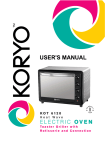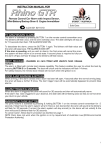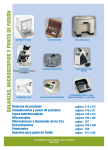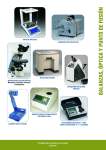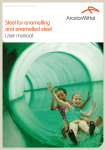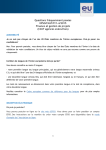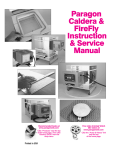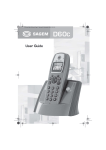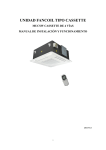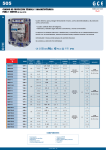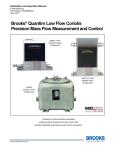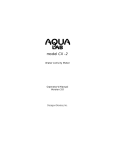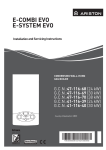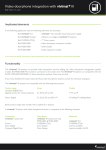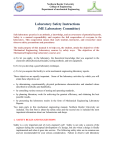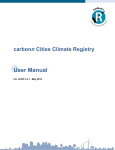Download user manual document
Transcript
2015 User’s Manual User’s Manual Index Self-assessment tool for the diagnosis, characterization and Introduction ....................................................................................... 3 o Objective .................................................................................. 4 of energy efficiency in o Who isimprovement it aimed ..................................................................... 5 Tool Requirements .......................................................... 6 industrial sectors. General Issues .......................................................................... 8 Footsteps ..................................................................................... 10 Report ............................................................................................ 14 Appendix I: Questions to be performed at different stages .................... 18 o Technical data on the company ...................................................... 19 o Boilers ..................................................................................... 21 o Refrigerators ................................................................................... 22 o Motors, fans, pumps, compressors ...................................... 23 o Horn ........................................................................................ 23 o Special furnaces ......................................................................... 23 o Dryers .................................................................................... 24 www.pineaudit.eu Disclaimer The sole responsibility for the content of webpage lies with the authors. It does not necessarily reflect the opinion of the European Union. Neither EASME nor the European Commission are responsible for any use that may be made of the information contained therein. 1 User’s Manual 1. Index 1. 2. 3. 4. 5. 6. 7. 8. 9. Index ............................................................................................................ 2 Introduction .................................................................................................. 3 Tool Requirements ...................................................................................... 5 Previous indications ..................................................................................... 6 Step by step ................................................................................................. 8 Report ........................................................................................................ 15 Helps.......................................................................................................... 21 Energy measure recommendations ........................................................... 30 Hints........................................................................................................... 46 2 User’s Manual 2. Introduction Target The purpose of this document is to serve as manual diagnostic tool, characterization and improvement of energy efficiency in industrial sectors, to be used in the first phase of scouting energy audits within the PINE project. The purpose of the application is to generate a self-assessment report as to show sectorally, and in a customized manner, the efficient use of energy resources of enterprises, allowing to determine the strengths and weaknesses of each, improving continuously saving in its activity, and thus provide greater value to their products or services. Who is it for? Welcome to the PINE self-assessment tool. This online tool enables companies from six specific production sectors to make a self-assessment of their energy performance, based on the last annual consumption period, and the main characteristics of their energy consuming systems and devices. After completing the questionnaire the tool gives a short summary of energy sources and consumption areas, and a set of generic and specific recommendations with approximate ranges of potential savings associated with the implementation of each specific recommendation. This assessment does not replace a real energy audit and provides general recommendations that may not always be implementable or feasible at each specific case. This tool is aimed at small and medium enterprises whose activity falls within one of the following industrial sectors and subsectors listed in the table below. Agrifood 1.15 3.15 4.15 7.15 15.81 / 15.82 15.91 to 15.97 15.98 Meat industry Processing and preserving of fruit and vegetables Manufacture of fats and oils Manufacture of animal feed Manufacture of bread, biscuits and bakery products Production of alcoholic beverages Mineral water and alcoholic beverages-an Metal 2.28 4.28 5.28 7.28 1.29 2.29 Manufacture of tanks, reservoirs and containers of metal Forging, stamping and roll forming of metal, powder metallurgy Treatment and coating of metals Manufacture of metal products, except furniture Manufacture of machinery and equipment nec Manufacture of other machinery, equipment and materials commonly used mechanical 3.29 5.29 Manufacture of agricultural Manufacture of other machinery for specific uses Chemical 1.24 2.24 Manufacture of basic chemicals Manufacture of pesticides and other agrochemicals 3 User’s Manual 3.24 Manufacture of paints, varnishes and similar coatings, printing ink and mastics 4.24 5.24 Pharmaceutical Manufacturing Manufacture of soap and detergents, cleaning and polishing. Manufacture of perfumes and hygiene Beauty 6.24 7.24 Manufacture of other chemical products Manufacture of man-made fibers Nonmetallic Mineral 1.26 2.26 Manufacture of glass and glass products Manufacture of refractory products and refractory, except for construction 3.26 4.26 Manufacture of ceramic tiles and tile Manufacture of bricks, tiles and clay products for construction Textile 1.17 2.17 3.17 Preparing textile fibers Manufacturing textile fabrics you Textile finishing Plastic 2.25 Plastic products On the left the NACE codes are shown. However, the software will prompt to choose a field of activity sorted out by description. NACE codes are then indicative. This model comprises around 80% to 85% of all the industrial SMEs. Since the sort of industrial processes vary significantly among sectors, a different analysis is done, according to the sector of activity. Many modules are equivalent (motors, HVAC, heating, furnaces, cooling, lighting, compressed air,…) and the subroutines are called as needed. The program is conceived to work in a decision tree model. Therefore, the decisions and information completed upstream will determine the questions and information required downstream. For this reason, some information cannot be retrieved as the information compilation progresses. Once the final report is generated there is no possibility to modify inputs as they may affect the whole questionnaire path. Hence, the only way to correct or modify inputs is by creating a new file and starting over again. 4 User’s Manual 3. Tool Requirements Being a Web application, you must have Internet access in the computer you want to access the questionnaire for "Self-assessment tool, characterization and improvement of energy efficiency in industrial sectors." The tool is optimized for the following browsers: Internet Explorer 6.0 and later Mozilla Firefox 2.0 and later Google Chrome Opera 8.0 and later For correct operation it is necessary that the javascript functions be enabled in your browser. It is also important to have a PDF reader program, and that the final document reported by the tool uses this extension. There is no way to install an access the program internally from a hard disk drive. Access to computer tool To access the software tool you must enter the the tool link as shown below: http://circe2.deweb.es/herramienta The initial screen of the tool is as follows. First you are asked to select one of the 6 major industrial sectors, and one of the available languages. Figura 1. Image screen software tool 5 User’s Manual 4. Previous indications Warning: If you have opened the application and pass a certain time without using it (about 5 minutes), it will return to the home page. To continue you must register again and return to the form he had last completed. Before completing the questionnaire "Diagnostic Tool, characterization and improvement of energy efficiency in industrial sectors", it is recommended to follow a set of guidelines that facilitate the subsequent use and proper completion of the forms included in it. 1. Person responsible for completing the tool It is recommended that the person responsible for carrying out the data entry in the tool has full knowledge of existing machinery in the company and its operation. Once started to fill in data, there is always the possibility to exit and continue later. Nevertheless it is very recommendable to get all the necessary information beforehand, so as to minimize the data entering time. The minimum information that will most likely be required by the software is: Latest energy supply invoices for a full year: electricity bill, gas bill, gasoil bill, coal bill, biomass and other supplies, with the amount of energy furnished and the unit cost, tax included. A list of energy consuming devices with its main characteristics: number, type of device, fuel used, power, age, average working hours per year, yearly turnover… General information about preventive maintenance scheduled, frequency and scope. Average number of workers, working days per year, working hours per day, and production volume to calculate energy intensity. A suggestion to speed up the data collection process is to contact the energy manager or technician in chart and let him/her know about this minimum data requirements so as to let them be prepared in advance prior to the visit. In the software tool there is a first set of general company data, and questions pertaining to the technical characteristics and use of the different equipment installed in the plant. It is not possible to continue the questionnaire without having completed the current screen. In the case of missing data at a given time, you may quit the tool by clicking on the link in the right top menu "log out”, and come back later but you cannot proceed any further as the missing data may be important to decide which questions come next. 6 User’s Manual The software tool saves the last form in which the data have been completed. When logging in again, you will be taken to the last completed field. 2. Description of devices In forms regarding equipment installed in the company, it is requested the number and name of the devices with a name less than 50 characters. It is recommended that the device name is significant because it will be the way to refer to calculated-saving measures proposed for that particular device. Example: If you enter the name of a freezer as " freezer one" the proposed measure will be shown as follows: This name is not recommended because it is very generic and may lead you to confusion when interpreting the final report. . If you enter the name of the boiler as boiler " cooking room boiler (15 kW) ", although the final report is reviewed after a while the boiler would be well defined on the savings measures proposed. 3. Format numbers In the course of completing the questionnaire relating to computer tool the user must enter a series of numerical data (Example: power), it is necessary to know the format to be used in these settings. If it's a figure of thousands: Ex: 1540 -> do not use separation dots to indicate a value greater than a thousand. If it's a decimal: Ex: 4.5 -> the decimal places must be separated with a dot ".", Do not use commas ",". 4. Helps Some questions in the questionnaire have the symbol , This indicates that you have "help" with explanatory information for a correct interpretation of the question and adequate completion of the same. 5. Correction of errors In case you need to rectify and return to previous screens, Use the back button at the bottom left. Once the necessary screens receded, it is again necessary to complete the questionnaire from the point at which a data is modified and onwards.. 7 User’s Manual 5. Step by step Every file or company data is kept and accessible by means of a username and password. Hint: use the company name or acronym as username. The password may be a personal password by user (always the same for each user) or it may be the username again, to remember it more easily. If you want to access an existing file for a given company, please insert the login and password corresponding to the company. If you want to create a new file, click on “Press here to proceed to the energy audit questionnaire Summarizing: To access the tool main screen there are two options: 1- Insert login and password should you be a registered user. This option is primarily used to continue the questionnaire if you have been abandoned at some point, or to access the pdf of the final diagnostic results for viewing at any time. 2- If not a registered user, you must click "here" and register for the first time to access the computer questionnaire tool. Figura 1. Log Mode in the tool 8 User’s Manual The questionnaire relating to the "scouting diagnosis tool, characterization and improvement of energy efficiency in industrial sectors" includes two types of questions: Company data and issues specific to the equipment installed in the company, their characteristics and mode of operation, well as the overall operation of the facility. The first screen after registering the generic data corresponding to the company, is as shown in Figure 6. At the end of the generic data questionnaire you will be requested to provide a username and a password for this particular company. If any of the compulsory data fields are empty or wrong they will be marked in red after pressing “continue” Figura 2. Screen details To continue the questionnaire and move on to the following screen, at least the mandatory fields marked with an asterisk (*). must be completed Then click on "Continue". Once the general data screen for the company, the different blocks in which the questions are divided for the sector of activity (NACE) to which your company belongs start: Technical data Boilers Cooling devices Engines, fans, pumps, compressors Furnaces. 9 User’s Manual On the left of the screen you will be informed about the module of information you are in. On the right top corner the company name and the log out button will be displayed. The first screen requests the amount of production per year in m2, litres, tonnes or kg, as well as a free text box for additional explanations about the type of product. One or more types can be filled in. Figura 3. Screen details for production volume. It shown in Figure 6, the various modules into which the screen is divided completion of the questions. The structure of all blocks independently is similar: 1- Modules of the tool: It left the area in which the block is to be completed over the computer tool. We can observe that there are two symbols: : Indicates the block in which module you are now : Indicates that the block has been completed and completed correctly. 2- Company name and log out button the tool: at the top right. It displays the name of the company that is conducting the survey 10 User’s Manual Besides, you have the option "log out", which allows you to quit the tool to continue from that point later. 3- Form: It is the main module of the screen, since it shows the questions, answer choices and aids for completing them. 4- Back to the previous form: This option, located at the bottom left, drives you back to previous screens on error in filling in the data. Once you get back the necessary screens, it is again necessary to complete the questionnaire from the point at which the tool is at that time. The reason is because whatever changes made in the entered information may entail a path change in the decision tree. In each of the forms, by continuing, any required information is missing, this will be marked in red as shown in Figure 8. Figura 4. Image display incomplete data At the end of each module a message communicates that you have successfully completed the module and indicates what will be the next module to appear. Some questions may not be clear. If a blue and explanations as the example below. , appears, you can click for further details Some questions are simply yes / no questions as in the example below. A default value will be proposed. 11 User’s Manual Figura 5. Yes / No questions Some questions may not be clear. If a blue and explanations as the example below. , appears, you can click for further details Figura 6. Help for a question 12 User’s Manual Every section starts by asking for the number of devices of each kind. You will be prompted to fill in a data sheet per each of the devices. If the company has several equal such devices you can fill in one, and copy the data for the following equipment, selecting it from the right column. Figura 7. List of devices to be described. Once inside the questionnaire, you will be requested to fill in the device characteristics depending on the device you are describing. An important data will the loading factor, from 0 to 1. If unknown a 0.75 default value will be assigned 13 User’s Manual Figura 8. Sheet for device technical data. 14 User’s Manual 6. Report Once you have completed all phases of the software tool, you enter the final report proposed measures for the company in question. The report is divided into several blocks, which are detailed below: First, there is a first block which general data of the company have been made to the tool. Figura 9. Image general report data Next, the report shows a pie chart showing the share of the existing company consumption by type of equipment. This diagram only shows consumer distribution outputs, if you want to also represent inputs, then you should open an energy Sankey diagram of the company in which both aspects are represented, for that purpose click on "View". This diagram will be added at the end of the report pdf version. 15 User’s Manual Figura 10. Company energy outputs diagram Figura 11. Sankey Diagram The next block in the report shows the general measures (without quantification) proposed to improve the energy performance of the company. For each of the measures the corresponding device described by the given name will be displayed in brackets. 16 User’s Manual Figura 12. General recommendations for energy improvement Following, there is a general measures block with those measures by type of energy that it is possible to quantify. Figura 13. Energy improvements report, quantified measures 17 User’s Manual As seen in Figure 13, the savings are quantified using a range of values. Below is an overview of the initial situation of the company, shown by a red bar, and the consumption after the implementation of the measures proposed in the diagnostic report shown by a green bar. Figure 14 shows the energy consumption by type showing the initial and the final consumption estimations. Please bear in mind that this is an average estimation of the savings achieved only by the full deployment of the quantitative recommendations. If the generic recommendations were implemented as well, the savings would be larger, although impossible to estimate.. Figura 14. Picture showing the initial and final company consumption estimation To summarize the actions proposed and the expected estimated impact a final summary table is provided, first showing generic qualitative measures and the associated equipment, and then, showing the quantitative measures and the amount and range of savings by type of energy as shown below. 18 User’s Manual Figura 15. Summary table with the generic recommendations and the associated equipment Figura 16. Summary table with the quantitative recommendations and the associated equipment, as well as the savings estimation. 19 User’s Manual Finally, there is a table with the percentage of savings by type of energy that would result from the implementation of the proposed measures. Thermal savings percentage 5 y 7 % Electric savings percentage 7 y 9 % Please bear in mind that This is an estimation range varying from a top number and a bottom number These are based on the implementation of all recommended measures and always compared to the best available technology. Hence, these are maximum ranges of expected savngs. The total savings will depend on the actual consumption. In case you want to save the final report document, print it, etc ... you can have it in PDF format, by clicking on "View document in PDF format" at the top of the final energy assessment report A final disclaimer is added, featuring the following statement: The sole responsibility for the content of this software lies with the authors. It does not necessarily reflect the opinion of the European Communities. The European Commission is not responsible for any use that may be made of the information contained therein. 20 User’s Manual 7. Helps Help 1: Is there insulation in the heat distribution pipes? To avoid heat losses, it is critical to ensure a good insulation of pipes and conducts. If cracks, total or partial lack of insulation material, or if an excess of heat are observed, the insulation is not good enough and should be improved. Help 2: Are there vegetable wastes in any of the company processes? Vegetable wastes are useful reusable biomass. Thus, it is important to know exactly how much wastes are generated, that can be recycled, in case they are of use internally or by another company, to get an extra profit out of them, or analyze the energy content and value. 21 User’s Manual Next table shows the energy content of usual vegetable wastes in industry. Caloric power Waste kWh/ kg Rice husks 3,46 Almond shell 4,61 Bark 4,24 Wood and conifer branches 4,19 Hardwood firewood and branches 3,85 Olive pomace 3,88 Grape pomace 3,77 Cereal straw 4,24 Paper 4,52 Pruning 3,85 Olive tree pruning 3,68 Vine shoots 3,82 Sawdust and shavings 4,41 Cloths 4,58 For comparison purposes, the natural gas or petrol calorific value is about 11.63 kWh / kg. In agrifood companies it is very common to obtain wastes that can be burned to get extra energy for the drying, curing and dehydration processes. In this case, bear in mind the local legal and environmental requirements to this regard. Help 3: Is there an automatic process control in your company? Automatic process control systems perform actions when detecting a gap between desired and actual value of a process parameter, with no human intervention. Through process automation, a closer process control can be done, improving the energy, operation and maintenance efficiency of the final product, by enabling equipments to work the closest possible to the optimum. Help 4: Fuel Type Fuels can be classified as: Solid: Firewood, charcoal, coal, , coking coal, … Liquid: Heavy oil, petrol, gasoil, kerosene, fuel-oil, alcohols … Gas:, Natural gas, propane, butane, acetilene, LPG … 22 User’s Manual Help 5: When checking the boiler performance, do you apply corrective actions to reach the recommended combustion parameters? A boiler’s performance is the ratio of useful heat produced (after losses) with respect to the fuel energy. Losses may come from exhaust gases, boiler insulation or purging flows. To evaluate this performance it is necessary to have a gas analyzer to measure the O2, CO2 & CO concentrations, and their exiting temperature, as well as the outside boiler temperature. The right values of O2, CO and the outlet gas temperature depend on the type of fuel and burner, as well as the boiler size. Target values will be provided at the equipment manual or through the manufacturer. Help 6: What is the full load operating time per year? Full load means nominal or design conditions. Roughly, working 24 hours at half load is equivalent to working 12 hours at full load. Full load operation means using less fuel per product unit and, thus, being more cost-effective. It is then more efficient to install several lower power equipments that may be activated or stopped depending on the work load, to ensure they work at the highest efficiency settings. Help 7: Is there a condensate recovery system? All heat distribution pipes and equipments present some condensation due to the different temperatures inside (at steam temperature) and outside the pipes (at ambient temperature). The energy content in the condensate can be more than 10% of the total steam energy content of a typical system. With a condensed water heat recovery system the purpose is not only recovering the water condensed, but also the thermal energy contained in it. Distribution losses 5% Combustion losses 13% DISTRIBUTION FLASH STEAM 10% STEAM GENERATION End of boiler purge 3% FUEL PRIMARY ENERGY 100% WASTED CONDENSATE FINAL USER CONDENSATE FLOW BACK Water refilling FINAL ENERGY 74% 23 User’s Manual Help 8: Is there usually ice covering the cabinet walls and coil? Frost accumulated either on the fridge and freezer inner walls, or on the coil, reduces the heat transfer and increases the energy consumption largely. Efficient anti-frost systems that identify temperature and evaporator pressure drop, or measure the humidity and frost accumulation are much better than those systems that get rid of the frost following programmed cycles. Help 9: Is the pressure switch adapted to changing conditions (winter/summer)? Cooling system compressors are limited by the top pressure (condensation) and bottom pressure (evaporation). The compressor pressure is controlled by a switch. The most adverse operating conditions occur in summer due to the high ambient temperature, that affects the device performance. Therefore, compressors are designed to work at the top pressure level, which is most likely not needed in winter. If the pressure switch settings are not changed, the equipment would be operating at summer worst case conditions, thus loosing efficiency for winter working conditions. Help 10: Is the cooling equipment fitted with an open door sensor? Sensors to detect open doors and acoustic signals to indicate an open door for a long time are features that help the user to be aware of misuses that are very energy 24 User’s Manual inefficient. Your equipment should be fitted with these items and they should work properly. Help 11: Are joints in good condition? Joints help to have a good insulation and reduce heat losses, However, due to intensive use, they usually deteriorate faster and may need replacement from time to time. Keeping joints in good condition are key to ensure good energy performance. Help 12: Is it usual that the equipment works at half the capacity? Several cooling equipment working at a given target temperature, but empty or partially filled up, imply a waste in space and capacity. Several such devices multiply consumption with respect to the ideal situation in which contents are gathered together in fully loaded equipments and the rest are switched off. Help 13: Are your equipments fitted with inverter technology and variable speed drive? Some screw compressor cooling devices are fitted with inverter technology. This technology controls the power to the target temperature at real time with no compressor on and off cycles. The top pressure is reduced and the power is adapted to the needs at all times. The energy consumption and the equipment lifetime get significantly improved. 25 User’s Manual Help 14: Is there any engine with variable loads? For engines that work at variable workloads it is very interesting to modify the working speed to match the optimum power, and prevent them from working at full power continuously. This is specially recommendable in the following cases: Pump drives Extractor drives Fan drives Compressor drives ……… Help 15: Load factor This indicator shows the electric equipment usage in a facility over a given period. It is defined as (lf) the ratio between the average demand in the period and the máximum demand in the same period.: Average Demand (lf) = ------------------------------Maximum Demand The most recommendable load factor is the closest possible to 1. Any value lower than 1 shows that the system is either over-dimensioned, or not used at its full potential. ¿How to calculate the Average Demand? Energy consumption DP = ----------------------------------------Number of operating hours Help 16: Is there a heat recovery system? Exhaust gases may exit the combustion chamber at a high temperature so as to transfer energy to other processes like water or inlet air preheat, to decrease the fuel consumption. Recovered heat can even be used in a different process like low temperature drying. economizers: equipments for process water preheating. preheaters. These are heat exchangers in charge of rising up the inlet combustion air. In any case, for oil fuels it is not possible to decrease the exhaust gases temperature below 150 - 175ºC, as the sulfuric acid condensation would corrode the pipes and equipment. In case of gas the exhaust gas temperature can decrease below the water condensation temperature. 26 User’s Manual Help 17: Number of full load operating hours? Full load means nominal or design conditions. Roughly, working 24 hours at half load is equivalent to working 12 hours at full load. Full load operation means using less fuel per product unit and, thus, being more cost-effective. It is then more efficient to install several lower power equipments that may be activated or stopped depending on the work load, to ensure they work at the highest efficiency settings. The number of operating hours would be the equivalent number of working hours if the device worked at full capacity, or nominal conditions. Help 18 Leaks in Compressed Air Systems The leak rate on an unmanaged compressed air system can be as much as 40% of the output. Compressed air leaks also lead to additional costs through: • Fluctuating system pressure, which can cause air tools and other air-operated equipment to function less efficiently — potentially stalling and affecting production • Reduced service life and increased maintenance of equipment due to unnecessary compressor cycling and running time • Excess compressor capacity. The sources of leakage are numerous, but the most frequent causes are: • Manual condensate drain valves left open • Shut-off valves left open • Leaking hoses and couplings • Leaking pipes and pipe joints • Leaking pressure regulators • Air-using equipment left in operation when not needed. Help 19 Heat recovery in Compressed Air systems One of the key cost-reduction opportunities is to re-use the waste heat generated by the compressor in a suitable application. Only 10% of the electrical energy driving an air compressor is converted into compressed air energy. The remaining 90% is 27 User’s Manual normally wasted as heat. A properly designed heat recovery unit can recover over 80% of this heat for heating air or water. Help 20: Air inlet position in Compressed Air systems Cold air is denser than hot air. If the inlet air is denser the energy needed to compress it will be lower. Therefore, it is recommendable to keep the air inlet outdoors. Help 21: Speed drive systems Speed drives are devices that are fitted to the AC engines and control both the starting and the running processes. This is very convenient in presence of resistant variable loads. It is particularly applicable to: Engines that drive pumps Engines that drive extractors Engines that drive fans Engines that drive compressors Help 22: Discharge lamps For discharge lamps there must be an auxiliary element, called ballast or reactance, whose purpose is to initiate the discharge and control it. There are 2 types of ballast Magnetic ballast. Use in industrial applications is declining due to its low efficiency and the inability to regulate the light output of the lamp. Electronic ballast. More efficient as they can regulate the luminous flux. Heating Water radiators: It is the most economical and simple system. Cast iron radiators have a higher thermal inertia and are more resistant than steel or aluminum. The distribution is more efficient for bitubular than monotubular configuration as it increases heat distribution. The surface temperature is 60 - 80 degrees C. Underfloor heating: Various crosslinked polyethylene pipes are placed 3-5 cm below the soil surface, with a spacing of 10 to 30 cm between them. By circulating water through the tubes at 45 degrees C, the soil is kept at 29 degrees. 28 User’s Manual Fan-coil units: equipment fitted with a heater with hot water inside and a fan that forces air to pass through it, warming it up. This equipment can also be used for cooling. Industrial cooling is usually generated by means of Refrigeration Tower: The equpments involved are fans and process cooling pumps. Compression Cooling. The equipments involved are compressors (different than compressed air systems) Adsortion Cooling. The equipments involved are Cooling pumps. What type of burners are your furnaces and dryers fitted with? High speed burners: they work by injecting a great volume of low temperature gases at a high rate. Heat is transmitted by convection Auto recycling burners: Combustion gases are driven into the flames. NOx emissions are reduced. Puls combustion burners: Combustion gases are circulated in a way that the temperature is more homogeneous all around the furnace. The gas feed enables an optimum use of the energy. What type of heating system is in operation in your company’ Boiler: Fuel + air are injected into the boiler chamber through a burner. The combination fuel + oxigene gives off thermal energy and, as a result, a number of byproducts are produced: solid wastes (ashes, slag) and exhaust gases at high temperature (from 200 to 1000 degrees). The energy contained in those gases is transmitted to a fluid (water, air, oil) by means of a heat exchanger before they are evacuated via a chimney. Electric heating: An electric current is forced through a resistance, producing heat this way. Heat pump: this is a device that generates heat for winter heating and extracts it for summer cooling, just by inverting the working cycle. It is based on the principle of heat transfer from a cold environment to a warm one by means of a mechanical energy as heat pumping. To invert the cycle a valve switches the flux direction and the condenser works as evaporator and viceversa. In terms of energy, it is a very efficient system since the thermal energy produced exceeds by far the electric energy applied. 29 User’s Manual 8. Energy measure recommendations For recommendations in yellow, an approximate % of savings is provided. GENERAL RECOMMENDATIONS Recommendation 1: ASSIGN AN ENERGY MANAGER POSITION IN YOUR COMPANY. Following up on energy consumption is critical to monitor the energy resources per unit of product and identify deviations with respect to the average values and the target values. A person or team should be nominated to take up this task and promote energy efficiency actions and report results. Recommendation 2: INSULATE PROPERLY THE HEAT DISTRIBUTION NETWORK TO MINIMIZE LOSSES. Energy losses can be significantly reduced if a proper insulation is done on distribution pipes, valves, tanks and any element where the temperature inside differs greatly from the ambient temperature. Savings: 3% . Recommendation 3: INSULATE PROPERLY THE HEAT DISTRIBUTION NETWORK TO MINIMIZE LOSSES. Energy losses can be significantly reduced if a proper insulation is done on distribution pipes, valves, tanks and any element where the temperature inside differs greatly from the ambient temperature. From 1-10 m of defective pipe insulation, savings can be up to 1% or original consumption. From 10-50 m of defective pipe insulation, savings can be up to 2% or original consumption. Beyond 50 m of defective pipe insulation, savings can be up to 3% or original consumption. Recommendation 4: IT IS RECOMMENDED TO MAKE A STUDY ABOUT THE POSSIBILITY TO REUSE THE VEGETABLE WASTES FOR ENERGY PURPOSES. Some by-products in agrofood industries can be considered as recyclable biomass, and be reused for different purposes, either by another company process, or by the own company process, seeking then an economic profitability. If it is no possible to use those wastes as by-products, it might be worth considering the reuse to generate energy. Recommendation 5: AUTOMATIC PROCESS CONTROLS OPTIMIZE THE PRODUCTION PROCESS. Many industrial processes are wasting energy as the manual control is not efficient. An automatic control can monitor the different process parameters and take the programmed actions to improve the energy efficiency. 30 User’s Manual Recommendation 6: USUALLY, CLEANING PROCEDURES ARE NOT ENERGYEFFICIENT AND THEY ALSO WASTE WATER. Cleaning tasks usually involve an important water consumption and energy consumption to heat up the water used in the cleaning. There are techniques that can reduce both. Some of them are described below: o o o Cleaning in Place enables to carry out the cleaning almost automatically, thus controlling the amount of water consumed, and therefore the energy contained in the cleaning water. Cleaning by means of low pressure foams to disolve the dirtiness, followed by a rinsing. This technique reduces the amount of water used and the associated energy. One step detergents: these products reduce the number of cleaning steps (disinfection, basic and acid treatment,) to just one, thus reducing the water consumption and the subsequent energy use. These efficient cleaning techniques may represent important savings at affordable costs. BOILERS GENERAL RECOMMENDATIONS Keep oven doors closed always good. Reduce load times and inoperación. Operate at maximum load. Use insulation to reduce heat loss. Use PLCs to control the consumption of the furnace and other parameters. The difference in consumption between an automated electric furnace and other manual is about 25%. Furthermore, the average life of the resistors in an electric furnace can even double. Ensure a good seal for the doors. Up to 80% of the loss of a furnace can be caused by opening the doors. Use size-adjustable inlets so that the opening is just enough to allow entry of the material but not higher to avoid unnecessary losses. Seek to work with the furnace at full load, instead of several partial loads. Rapidly charge the feedstock to reduce radiation losses of the furnace. Also, try to extend working times as much as possible to avoid having to preheat the oven every time you want to use it. Ensure that the idling time is minimized. Reduce testing and repair times. Preheat the load if possible by heat of exhaust gases from other processes. Use any resulting byproduct, such as water cooling from induction furnaces, exhaust gases ... You can use the heat stored to feed other processes such as preheating another furnace, drying a product, etc. 31 User’s Manual Recommendation 7: APPLY CORRECTIVE ACTIONS TO REACH THE RECOMMENDED COMBUSTION PARAMETERS WHEN CHECKING THE BOILER PERFORMANCE. The correct values of O2, CO and exhaust gases temperature depend on the type of fuel and burner used and the boiler’s size. A regular checking of the exhaust gases should be done, and compared with the optimum given by the boiler manufacturer. As a reference, the correct values are: Combustible O2 max (%) CO max (ppm) Fuel-oil Gasoil Natural Gas 3,5 3,5 2 200 200 50 If the measured values do not correspond to the ones recommended then the boiler is not working fine. Some adjustments and fine-tuning might be required, as well as a proper preventive maintenance. Savings may be up to 6.5% of the initial equipment consumption. Recommendation 8: CARRY OUT PERIODICAL EQUIPMENT MAINTENANCE. Regular preventive maintenance should be done, following the manufacturer guidelines. Frequency as stated by the manufacturer, at least once a year and depending on the equipment use. Recommendation 9: INSTALL A CONDENSATE RECOVERY SYSTEM TO SAVE ENERGY AND WATER. These systems aim to return the condensed water at the maximum possible temperature to the water feeding system to recover both the water and the thermal energy contained in it. Approximate savings: If Temp > 130º, thermal savings 4% If Temp < 130º, savings 2% Average savings 3% Recommendation 10: FIND OUT THE PROCESS AND EXHAUST GASES TEMPERATURE TO FINE-TUNE THE COMBUSTION PROCESS. Knowing the process temperature to supply hot water or process steam will allow to set the heat production to the process needs, avoiding energy wastes. An excess on exhaust gases temperature may entail an energy waste at the outlet gases. This temperature can be obtained by measuring directly at the boiler outlet. This value is always taken and reported in the annual maintenance report and should be tracked in the boiler’s maintenance book. The maximum exhaust gas temperature varies according to the fuel used. If: Gas fuels: 175ºC Liquid fuels: 230ºC Solid fuels: 230ºC 32 User’s Manual Recommendation 11: REVISE THE EXTERNAL BOILER INSULATION AND REFRACTORY MATERIAL A too high outer surface temperature around the boiler may indicate that the equipment is not sufficiently insulated, and therefore, there is an energy waste through the boiler surface. Improvements in the boiler insulation material, increasing thickness of the insulation layer and checking the refractory material is needed. This also contributes to a safer operation, avoiding burns and accidents. Heat losses may be reduced up to 7080%. Savings for the equipment 2%. Recommendation 12: BOILER CLEANING A too high exhaust gases temperature may be the cause of an inefficient heat exchange inside the boiler. This issue is usually solved by means of an inner cleaning. This cleaning should be done on a regular basis to increase the useful heat and decrease the exhaust gases temperature. Savings are estimated to be 1% with respect to the current consumption for every 20º of exhaust gases temp exceeding the maximum value. Recommendation 13: INSTALL A HEAT RECOVERY SYSTEM Exhaust gases in high temperature processes may contain enough energy to preheat the inlet combustion air and reduce the energy consumption this way. This effect can be achieved by installing a pre-heater which is a heat exchanger to capture part of the outlet air energy and transfer it to the inlet air. If the excess of heat is reused to heat up water, then the equipment to install is called economizer. To know the equipment that best fits in your facilities, please seek expert advice. . Recommendation 14: BOILER REPLACEMENT BY A NATURAL GAS BOILER After 15 years of use a boiler may need replacement as the boiler performance decreases along time. If there is access to Natural Gas supply then it is highly recommendable to replace the old boiler by a natural gas boiler, as they are more efficient and less polluting. It can be obtained saving up to 15% with respect to the current consumption if the previous boiler was not a natural gas boiler. Recommendation 15: BOILER REPLACEMENT BY A NEW BOILER WITH SAME FUEL After 15 years of use a boiler may need replacement as the boiler performance decreases along time. If there is no access to Natural Gas supply then the option is to replace the old boiler by a boiler using the same fuel.. It can be obtained saving up to 10% with respect to the old boiler Recommendation 19: FIND APPLICATIONS TO USE THE CONDENSATE HEAT RECOVERY SYSTEM TO SAVE ENERGY AND WATER. 33 User’s Manual These systems aim to return the condensed water at the maximum possible temperature to the water feeding system to recover both the water and the thermal energy contained in it. IF the system is not used, it would be very interesting to find an application or process to use the recovered energy, for instance to complete the hot water supply. Approximate savings: If Temp > 130º, thermal savings 4% If Temp < 130º, savings 2% Average savings 3% COOLING EQUIPMENT AND REFRIGERATORS: GENERAL RECOMMENDATIONS There are high-efficiency fans for the evaporator and condenser requiring less energy to operate and generate less heat, thereby reducing the cooling needs. The savings potential is estimated between 3 and 15%. Likewise, there are high efficiency compression systems that allow savings between 6 and 16% depending on the refrigeration equipment used. Evaporative condensers use a soaked filter to cool outside air, increasing its ability to give off heat. savings may vary between 3 and 9%. when replacing the dry coolers, whose power consumption is high, for these wet systems Pressure amplifiers for the liquid side are small cooling pumps located after the condenser, that increase the pressure of the liquid refrigerant before entering the expansion valve. This increased pressure provides an additional cooling, improving the system efficiency up to 20%. Reducing the temperature of the liquid refrigerant below its condensation temperature (subcooling process), increases the cooling capacity of the refrigerant and reduces both the refrigerant amount and the time the compressor must be running. This operation can be performed with ambient air (ambient subcooling) or with an additional cooling system (mechanical subcooling). The latter system savings can reach 25%. Environmental subcooling capacitors require greater size or additional heat exchangers to subcool the refrigerant and savings vary between 1 and 9%. Moisture heaters are electric heaters that are installed in medium and low temperature cooling systems to keep the outer surfaces free of condensation. Typically these systems are powered continuously, but if installing a moisture control device, the heaters turn on or off according to need. Energy savings can reach 20%. Finally, heat recovery systems to warm water with the residual heat released from cooling equipment. can be installed. This allows for reduced energy for hot water needs. 34 User’s Manual Recommendation 20: PERFORM REGULAR EQUIPMENT CHECKS AND PREVENTIVE MAINTENANCE It is recommended to perform regular equipment checks and preventive maintenance to ensure the best working conditions. Maintenance should be as frequent as stated by the manufacturer, and at least once a year. Recommendation 21: DEFROST PERIODICALLY A good maintenance can ensure up to a 25% reduction in the operating costs of the refrigerators. One recommendation is to defrost the coil and clean the condenser. The efficient no-frost systems detect humidity, measure the frost accumulation and detect the evaporator pressure drop to achieve defrosting with no need of programmed defrosting cycles. Recommendation 22a: SET THE EQUIPMENT PRESSURE SWITCH ACCORDING TO THE YEAR SEASON (WINTER / SUMMER) Cooling system compressors are limited by the top pressure (condensation) and bottom pressure (evaporation). The compressor pressure is controlled by a switch. The most adverse operating conditions occur in summer due to the high ambient temperature, that affect the device performance. Therefore, compressors are designed to work at the top pressure level, which is most likely not needed in winter. If the pressure switch settings are not changed, the equipment would be operating at summer worst case conditions, thus loosing efficiency for winter working conditions. There are potential saving of 2% with respect to initial equipment consumption Recommendation 22: ENSURE THECORRECT FRIDGE AND FREEZER DOOR CLOSING BY MEANS OF AN OPEN-DOOR SENSOR. This system warns the user if the equipment door has been left open totally or partially, in order to avoid thermal losses. In the worst case, it is at least recommended to attach warning messages to alert users to keep the doors closed. Recommendation 23: ENSURE JOINTS GOOD CONDITION Joints avoid thermal losses between doors and equipment cabinet, by ensuring air tightness. These joints get deteriorated by intensive use and a revision and replacement if needed is recommended. Recommendation 24: SET AN APPROPRIATE TEMPERATURE SETPOINT ACCORDING TO THE STORED PRODUCT NEEDS . Lower temperatures than the minimum needed to store safely the product bring about an energy waste. Recommendation 25: PROTECT CONDENSER FROM DIRECT SOLAR RADIATION. Condensers are sensitive to ambient temperature, reducing the heat exchange efficiency as it goes up. This is why the condenser has to be kept away from sunshine and heat sources, and they should be located in well-ventilated places. 35 User’s Manual Saving of 2% with respect to initial equipment consumption can be achieved. Recommendation 26: COOLING EQUIPMENT SHOULD WORK AT FULL LOAD. Cooling equipment should work at full capacity to increase energy efficiency. If there are several refrigerators working at the same temperature and partially loaded, it is recommended to unify loads into fewer equipments at full capacity, and switch all the non-used devices. Recommendation 27: FRIDGE / FREEZER REPLACEMENT BY A NEW ONE WITH INVERTER TECHNOLOGY. This technology ensures much lower consumptions by adapting the compressor speed to the actual pressure needed to meet the target temperature, keeping it to a more stable and constant value, instead of the usual on-off cycles by former technologies. It also increases the device lifetime, by reducing the on-off cycles. This action can save as much as 40% with respect to the present situation. Recommendation 28: INSULATE THE PIPE SECTION FROM COMPRESSOR TO EVAPORATOR The overall system efficiency increases by reducing thermal losses in critical areas like the pipe that goes from the compressor to the evaporator. It is, then, critical to insulate this section properly to obtain savings of around 3%. ELECTRIC ENGINES, PUMPS, FANS, COMPRESSORS Recommendation 30: ENGINE REPLACEMENT BY A HIGH EFFICIENCY ONE. For heavily used engines (more than 15 hours/day) older than 10 years it is strongly recommended to replace conventional technology engines by high efficiency ones, saving up to 40% with respect to the initial engine consumption. High efficiency engines provide the same power at a much lower consumption, and extend the device lifespan. They work better out of the nominal conditions and at low temperatures. Savings can get up to 45%. Recommendation 31: CARRY OUT REGULAR REVISIONS Periodical revisions and preventive maintenance are needed to ensure the best working conditions for the electric engines, at least once a year. Special Recommendation 32: INSTALL VARIABLE SPEED DRIVES FOR ENGINES > 4 kW THAT WORK AT VARIABLE LOADS. For engines submitted to variable loads, it is interesting to be able to modify the engine speed to adapt the power to each moment’s needs, instead of wasting energy by making the engine work at full power at all times. This is achieved by means of a variable speed drives that, at the same time, smooth the start up profile to provide a more efficient working condition. 36 User’s Manual This is very convenient in presence of resistant variable loads. It is particularly applicable to: Engines that drive pumps Engines that drive extractors Engines that drive fans Engines that drive compressors Recommendation 33: INSTALL COMPRESSOR AIR INLET OUTDOORS The colder the air the denser it is, and therefore, the lower the energy necessary to compress it further. Hence. it is recommended that compressed air systems take the air right from the outside to ensure it is colder than inside air except for some cases of extreme summer wheather Recommendation 34: SWITH OFF COMPRESSED AIR EQUIPMENS AT WEEKENDS AND IDLE TIMES. If not in use, switch off the compressed air system at weekends and whenever is not going to be used to reduce energy consumption and extend the system lifetime. Recommendation 35: REPLACE COMPRESSOR For old compressors that work more than 15 hours/day, it is recommended to replace the compressor by a high efficiency one, obtaining savings of 40% of the original compressor consumption. Recommendation 36: COMPRESSED AIR PREVENTIVE MAINTENANCE OF LEAKS . The higher the pressure the higher the leaks. There should be regular revisions to ensure that there are not air leaks in the system. The leak rate on an unmanaged compressed air system can be as much as 40% of the output. Compressed air leaks also lead to additional costs through: • Fluctuating system pressure, which can cause air tools and other air-operated equipment to function less efficiently — potentially stalling and affecting production • Reduced service life and increased maintenance of equipment due to unnecessary compressor cycling and running time • Excess compressor capacity. The sources of leakage are numerous, but the most frequent causes are: • Manual condensate drain valves left open • Shut-off valves left open • Leaking hoses and couplings • Leaking pipes and pipe joints • Leaking pressure regulators 37 User’s Manual • Air-using equipment left in operation when not needed. Recommendation 37: Heat recovery in Compressed Air systems One of the key cost-reduction opportunities is to re-use the waste heat generated by the compressor in a suitable application. Only 10% of the electrical energy driving an air compressor is converted into compressed air energy. The remaining 90% is normally wasted as heat. A properly designed heat recovery unit can recover over 80% of this heat for heating air or water. FURNACES Recommendation 40: GENERAL RECOMMENDATIONS Glass surface is an important factor in the formation of particulates and other air pollutants. Changes in the design of the furnace or attempt to improve the energy transmission trav? S vitrifiable mass so that the temperature of the glass surface is m? S low. Replace the fuel with natural gas as primary energy in the drying means an easier control and regulation and energy savings? Tico to improve process efficiency and reduce the emission? No particulate, SOx and CO2. With the sealing of the furnace walls and c? Maras reduces parasitic air inlet presence of NOx increases thereby reducing the emission of these flue gases and reducing energy consumption, further improved refractory materials enables reduce heat loss from the oven and extending the useful life thereof. Recommendation 41: FIND OUT THE EXHAUST GASES TEMPERATURE TO FINE-TUNE THE COMBUSTION PROCESS. An excess on exhaust gases temperature may entail an energy waste at the outlet gases. This temperature can be obtained by measuring directly at the furnace outlet. This value is always taken and reported in the annual maintenance report and should be tracked in the furnace’s maintenance book. Recommendation 42: CARRY OUT REGULAR REVISIONS Periodical revisions and preventive maintenance are needed to ensure the best working conditions for the furnaces, at least once a year. . Recommendation 43: REVISE THE EXTERNAL FURNACE INSULATION AND REFRACTORY MATERIAL A too high outer surface temperature around the furnace may indicate that the equipment is not sufficiently insulated, and therefore, there is an energy waste through the boiler surface. Improvements in the furnace insulation material, increasing thickness of the insulation layer and checking the refractory material is needed. This also contributes to a safer operation, avoiding burns and accidents. Heat losses may be reduced up to 70-80%. Savings for the equipment 1.5%. 38 User’s Manual Recommendation 44: Exhaust gases temp: INSTALL A HEAT RECOVERY SYSTEM TO REUSE THE EXHAUST GASES TEMPERATURE. Exhaust gases in high temperature processes may contain enough energy to preheat the inlet combustion air and reduce the energy consumption this way. This effect can be achieved by installing a pre-heater which is a heat exchanger to capture part of the outlet air energy and transfer it to the inlet air. If the excess of heat is reused to heat up water, then the equipment to install is called economizer. To know the equipment that best fits in your facilities, please seek expert advice. Savings can be up to 15%. Recommendation 45 Revise Heat Recovery system.: REVISE THE HEAT RECOVERY SYSTEM MAINTENANCE, WORKING CONDITIONS AND DIMENSIONING. If the heat recovery system is installed but the exhaust gas temperature is above the maximum, the heat recovery equipment may not work properly or may not be properly dimensioned. Perform a preventive maintenance, a thorough cleaning and analyze whether the equipment is the most appropriate for your needs. Recommendation 46: FIND OUT THE PROCESS TEMPERATURE It is important to know the range of process temperatures to set the furnace to the right temperature and avoid a waste of energy. Recommendation 47: INSTALL AN AUTOMATIC CONTROL SYSTEM FOR THE THERMAL EQUIPMENTS. Recommendation 48: REGENERATIVE FURNACES Recommendation 49 : REPLACE HEAT RECOVERY FURNACE BY REGENERATIVE IF PRODUCTION > 40 TN/DAY. HEAT RECOVERY FURNACEs are mainly used for flexible processes with low capacity (<40 tn/day). Above this production it is better to install a regenerative furnace. Recommendation 50: REPLACE ELECTRIC FURNACE BY HEAT RECOVERY FURNACE IF PRODUCTION BETWEEN 20 AND 40 TN/DAY AND REPLACE BY REGENERATIVE IF PRODUCTION ABOVE 40 TN/DAY. Electric furnaces are economically feasible up to 20 tn/day, depending on the electricity cost and fossil fuel prices. For productions between 20 to 40 tns / day it is best to use HEAT RECOVERY FURNACEs. Recommendation 51: COMBINED FURNACES Recommendation 52: REPLACE BATCH FURNACE BY HEAT RECOVERY FURNACE IF PRODUCTION BETWEEN 20 AND 40 TN/DAY AND REPLACE BY REGENERATIVE IF PRODUCTION ABOVE 40 TN/DAY. Batch furnaces are adequate for low glass productions of different types. For productions over 40 tn/day it is best to use regenerative furnaces. 39 User’s Manual Recommendation 53: REPLACE THE BURNER BY ANY OF THE FOLLOWING TECHNOLOGIES * HIGH SPEED BURNER * AUTO RECYCLING BURNER * PULSE COMBUSTION BURNER Burners mix fuel and air just before combustion takes place.The most efficient burners compared to the standard are * HIGH SPEED BURNERS * AUTO RECYCLING BURNERS * PULSE COMBUSTION BURNERS Recommendation 54: REUSE THE OUTLET AIR HEAT RECOVERED FROM THE DRYING PROCESS. Recommendation 55: REPLACE THE EXTRUDER CYLINDER HEATING SYSTEM BY AN INDUCTION HEATING SYSTEM Energy peaks are avoided as the cylinder temperature is more homogeneous and the heating / cooling cycles of the standard system are no longer required. With this technology are achieved efficiencies above 95%, with a reduction of energy losses close to 98% and a reduction in power consumption of up to 70%. saving of 21% with respect to the initial equipment consumption Recommendation 56: MAKE AN IN.DEPTH FURNACE SEALING AND USE HIGH EFFICIENCY REFRACTORY MATERIALS This measure prevents heat losses and, hence, the energy efficiency increases. Recommendation 57: REPLACE THE CURRENT FURNACE BY A CONTINUOUS FURNACE. In general, it is recommended the use of continuous-type furnaces (tunnel) versus discontinuous. Continuous operation can increase the quantity and quality of the product reducing the cost of labour and reducing the specific fuel consumption significantly. Specifically, while the thermal efficiency of a tunnel oven is higher than 70-75% , the performance of a discontinuous oven is between 50-55% Recommendation 58 MAKE IMPROVEMENTS IN THE HEAT RECOVERY SYSTEMS OF THE REGENERATION CHAMBERS It is convenient to check the internal layout to enable a better heat transfer. Recommendation 59: INSTALL A HEAT AND POWER SYSTEM 40 User’s Manual It is recommended to study the feasibility of a Heat & Power system to reuse the heat energy to generate electricity Recommendation 58a: REPLACE YOUR CURRENT DRYER BY A NATURAL GAS DRYER. Natural gas is more efficient as a fuel, and emits lower SOx, polluting particles and CO2 Recommendation 59a: REPLACE CURRENT BURNERS TO ENABLE NATURAL GAS CONSUMPTION. These burners enable the shift to Natural Gas as a fuel, benefiting of the higher fuel efficiency and lower SOx, CO2 and particle emissions and ensuring a 5% fuel consumption reduction HEATING AND COOLING IN BUILDINGS GENERAL RECOMMENDATIONS FOR HVAC Whenever the outdoor temperature is below 25 ° C and humidity levels are very high, natural ventilation can solve the cooling problems of the rooms. To avoid unnecessary heat sources, such as excessive light, too many devices that produce heat, etc. This equipment should be turned off when not in use. At the moment you turn the air conditioning system, all doors and windows of the premises must be securely closed to prevent cold air losses If the room is to be unoccupied for more than four hours, the thermostat must be set at 28 ° C. Turning off the system 30 minutes before the stay is completely empty, savings are achieved without any loss of comfort. Prevent cold air stream falls directly on the occupants of the room. If the air conditioner has adjustable blades, you have to direct it towards the ceiling. The air pipes must always be well sealed, well insulated and free of obstructions. Otherwise, the efficiency of a centralized air conditioning would drop significantly. The service technician should also check the electrical connections and contacts, and the refrigerant charge. Electrical connections are common sources of errors, especially when the equipments turn on and off often. System efficiency will decrease significantly when the refrigerant amount does not match exactly the manufacturer's specifications. Recommendation 60: SET THE RIGHT TEMPERATURE SETPOINT DEPENDING ON THE YEAR SEASON 41 User’s Manual Every degree above 20º C, 6% savings in heating consumption. Confort temperature range varies from 20 to 25º. For Winter the ideal temperature should be set at 20º, whereas in summer the ideal temperatura should be 25º. Recommendation 61: INSTALL A HEAT PUMP HVAC SYSTEM IN YOUR INDOOR FACILITIES. Heat Pumps are reversible systems that exchange heat from the interior of a building to the ambient by means of an additional energy input. The lower the temperature gap the lower the energy consumption. This system is self-regulated according to the inner temperature setpoint and the ouside temperature. Heat Pumps are usually more efficient than other HVAC systems. Recommendation 62: INSTALL AN UNDERFLOOR HEAT DISTRIBUTION SYSTEM. Hot air is lighter and tends to go up. A radiant floor distribution system covers all the room surface thus providing a more homogeneous temperature and a better confort feeling at a lower energy consumption. Recommendation 63: INSTALL A REGULATION AND CONTROL SYSTEM. To adequate the heating to the ambient external conditions it is strongly recommended to put in place a regulation and control system. Savings can be up to 20 % in heating consumption. Recommendation 64: USE EAVES, AWNINGS OR CANOPIES TO KEEP OUT DIRECT SUNLIGHT IN SUMMER. Stopping direct sun radiation from breaking through is a good way to save in Cooling systems in summer. Recommendation 65: COVER HVAC CONDENSERS FROM DIRECT SUNSHINE. Since the HVAC systems increase efficiency when the temperature gap is low it is adviced to keep the condensers away from the sunshine. Recommendation 66: SET THE TEMPERATURE CONTROLS IN APPROPRIATE REPRESENTATIVE LOCATIONS. To ensure a right automatic control, the sensor should be placed away from windows, doors, radiators, air conditioning splits, and close to the working places. Recommendation 67: CARRY OUT REGULAR CLEANING AND MAINTENANCE OF THE COOLING SYSTEM Preventive maintenance and regular cleaning facilitates a more efficient heat exchange and improves the cooling system efficiency. There is a 6.5% savings in cooling consumption 42 User’s Manual GENERAL RECOMMENDATIONS FOR COOLING GENERAL ENERGY ACCOUNTABILITY Being aware of the company's energy consumption is of paramount important to be able to identify abnormal consumption peaks due to a misuse or fautly equipment. Knowing where energy is consumed is the first step towards an efficient use of it and can also help to identify the first easy measures to save energy. It is also recommendable to create the position of energy manager to give continuity to any efficiency measures. GENERAL RECOMMENDATIONS FOR COOLING Changing some parts of the cooling system existing can significantly improve the overall performance of the system. Savings vary between 1 and 20%, depending on the technology employed. The following are the devices that can improve the efficiency of the equipment. It should be noted that no all of them are complementary. • There are high-efficiency fans for the evaporator and condenser they need less energy to operate and generate less heat, thereby reducing the cooling load. Savings energy potential is estimated between 3 and 15%. • In the same way, there are also compression systems allowing high efficiency savings between 6 and 16%, depending on refrigeration equipment used. • adjust pressure modifiers pressure compressor according to external environmental conditions. The estimated savings are between 3 and 10%. • Evaporative condensers use a damp filter cool outside air, increasing its ability to detach heat. When I replace the dry coolers, whose consumption electricity is high, for these systems, the savings can vary between 3 and 9%. • amplifiers liquid line pressure are small coolant pumps located after the condenser, increasing the pressure of the liquid refrigerant before entering the expansion valve. This increased pressure provides subcooling the refrigerant, improving efficiency system. They can save up to 20% Reduced energy costs for the company • Lowering the temperature of the liquid refrigerant below from its condensation temperature (subcooling process) increases the cooling capacity per unit of refrigerant and time must be the compressor operation is reduced because less is needed refrigerant. This operation can be performed with air environment (environmental subcooling) or with a system of additional cooling (mechanical subcooling). Savings This last system can reach 25%. Subcooling environmental capacitors requires higher size or additional heat exchanger to subcool coolant and savings vary between 1 and 9%. 43 User’s Manual • Efficient lighting such as fluorescent T-8 or electronic ballasts (see section 1.5.1), can reduce consumption electrical and cooling load on the compressor. The Savings can be up to 10%. Additional savings can achieved by installing lighting controls, that turn off lights when not in use. • Moisture heaters are electric heaters that are installed in refrigeration medium and low temperature to maintain external surfaces free of condensation. Typically these systems are on continuously, but if a control device installed moisture, the heaters are switched on or off of according to the needs. The energy savings can reach 20%. • The frost that occurs in the walls of refrigerators, freezers, etc. heat transfer decreases and significantly increases the energy consumption. Systems Frost improve efficient defrost cycle, identifying the fall of evaporator temperature or pressure or by measuring the accumulation of frost and detecting the humidity. These systems are more efficient than starting defrosting cycles following scheduled. Savings vary between 1 and 6%. • Finally, it can pose recovery systems heat, which heats the water with heat from the equipment cooling. This allows for energy reductions for hot water needs. Recommendation 70: SET AN APPROPRIATE TEMPERATURE TARGET FOR THE HVAC SYSTEM The recommendation for indoor confort temperature is 20 degrees for winter and 26 degrees for summer. A different temperature setpoint is a waste of energy and may not result in a greater confort level. Every degree above 20 may imply an energy overconsumption of 5 to 7%. Recommendation 71: REPLACE THE HEATING SYSTEM BY A HEAT PUMP SYSTEM Heat Pumps are very efficient systems that can provide more thermal energy than the electricity energy consumed. Final consumption can be up to a 50% lower than a heating conventional system. LIGHTING Recommendation 90: INSTALL ELECTRONIC BALLAST PRIMERS FOR THE DISCHARGE LAMPS. In case of fluorescent lamps, low consumption lamps or Sodium or Mercury vapour lamps install electronic ballast primers as they reduce the energy peak for the lamp start up and help control the reactive energy. Recommendation 91: REPLACEMENT OF INCANDESCENT BULBS BY LOW CONSUMPTION LAMPS. 44 User’s Manual Whenever possible, replace incandescent bulbs by low consumption lamps. If the working hours are high, consider the LED lamps as savings are even greater. Recommendation 92: CONSIDER THE USE OF LED TECHNOLOGY LAMPS. If the lamp is on for a long time throughout the year, then consider the possibility of using LED based lamps. They are more expensive but savings are even greater. Recommendation 93: SET A LIGHTINGPREVENTIVE MAINTENANCE PLAN. This plan should include cleaning and revision. Having the walls and ceilings painted in light colours helps to reduce the ligthing consumption. Recommendation 94: CONSIDER REPLACING THE HGH PRESSURE MERCURY VAPOUR LAMPS BY SODIUM VAPOUR LAMPS Sodium vapour lamps are more efficient than mercury vapour lamps while giving the necessary lighting quality and quantity for outdoor lighting, although the light is rather yellowish. 45 User’s Manual 9. Hints This section provides valuable hints about how to deal with and overcome some limitations of the self-assessment tool. It is an on-going work that is being updated as new information arises. 1. 2. 3. 4. When talking about pumps in Industrial Cooling we are talking about heat pumps. Fluid pumps are included in the “motor, fans, pumps and compressor” sections. The calculation program calculates the electrical consumption by multiplying the nominal power by the number of working hours per year. The value is corrected by the load factor. If no load factor provided, it is assumed 0.75 as an approximation. The final consumption is the addition of the individual consumption of each device. Motors’ individual consumption is not calculated as it might require too much data depending on the number of motors. These devices, as well as other minor consumptions are deducted from the total electricity consumption. If the sum of all single device consumptions exceed the company electricity consumption a warning sign will be shown. You may be given the chance to change either the parameters of the reported devices or the overall energy consumption in order to assort the numbers. All the numbers and energy balance will be shown in cells that can be changed until reasonable numbers are achieved. Savings for motors, pumps, fans and compressors are usually assessed following 2 criteria. Age: older than 10 years means a high likelihood of low efficiency compared to today’s standards. In this case, a replacement makes sense only in case this motor be submitted to an intense usage (>15 h/day). To 46 User’s Manual 5. 6. calculate the approximate savings the software considers a 40% of the current consumption, estimated as P nom * 20 h/day * number of working days / year. Variable loads for engines > 4 kW, recommending the use of speed drives. In some sectors like food and agriculture, building consumptions are not relevant. Hence there are no questions about HVAC. However, it is interesting to include the heating boiler in the list of consuming devices. This consumption is more significant in other sectors like chemical or textile and specific questions are asked. In case that an unexpected value is requested by the tool and this value is not available you cannot go on with the data entering. Then you can log out and search for the data. Next time you log back in by using the password and login of this company, you will be automatically driven to the last unfilled screen, so as to proceed with the work. Do not go on with a blank field. Otherwise you may not be able to go back to retrieve that blank later. 47 User’s Manual Disclaimer The sole responsibility for the content of webpage lies with the authors. It does not necessarily reflect the opinion of the European Union. Neither EASME nor the European Commission are responsible for any use that may be made of the information contained therein. 48
















































